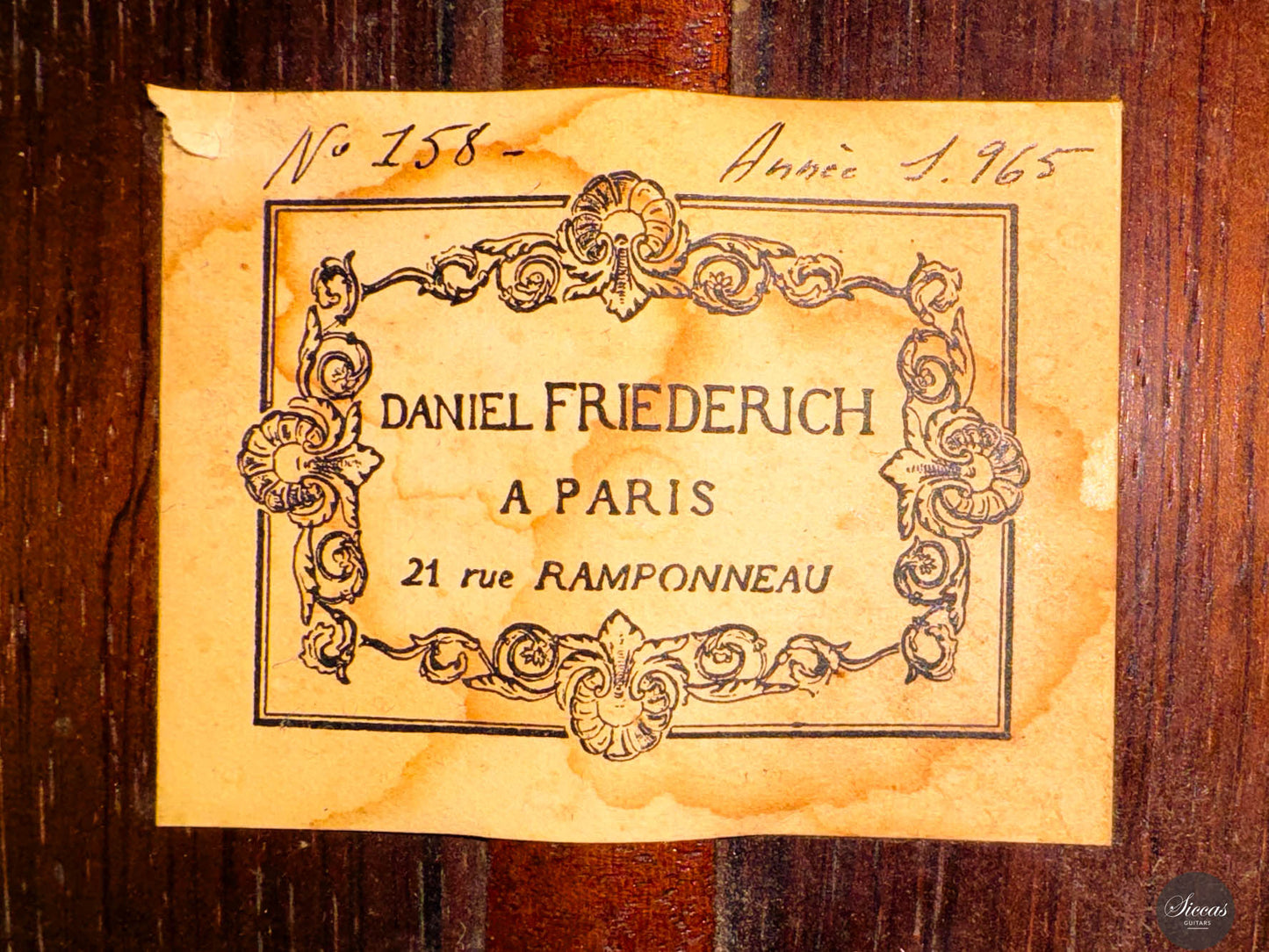Daniel Friederich - 1965 - Concert Nr. 158
Daniel Friederich - 1965 - Concert Nr. 158
Details
Details
Overview
Overview
Shipping important note
Shipping important note
Delivery times are typically reliable and most instruments arrive within the estimated timeframe.
Should any unexpected delay occur, our team will keep you informed and provide support at every step. For all shipping details and exceptions, please see our Shipping Policy.
Details about GPSR
Details about GPSR


























Video overview




More details about the guitar
About the luthier
Daniel Friederich, born on January 16, 1932, made an indelible mark on the world of classical guitar lutherie, leaving behind a magnificent legacy after his passing in 2020. Initially unable to afford a guitar, Friederich turned to craftsmanship, building his first instrument, a Simplicio replica, at the age of 23. Under the guidance of his teacher and skilled luthier Christian Aubin, he gained both tools and confidence. Friederich’s work took a pivotal turn after his fifteenth guitar when he met the esteemed luthier Robert Bouchet, whose mentorship profoundly influenced his style. Bouchet’s ideas became a foundational inspiration that Friederich continued to develop throughout his career, merging tradition with innovation. Over the decades, Friederich became one of the world’s most respected luthiers, his reputation enduring even after he stopped creating guitars in 2015, having sold his tools. Today, he is celebrated as one of the most admired guitar makers in history.About the guitar
The “Concert Model” No. 158, crafted in 1965 by the esteemed luthier Daniel Friederich, holds a significant place in the realm of classical guitars, marking the inception of his celebrated career. Inspired by the great Antonio de Torres, this guitar features a meticulously crafted spruce soundboard with a modified seven-fan bracing system—reflecting the third evolution of Friederich’s bracing design. This innovative construction yields a sound that is both rich and resonant, with vibrant depth and clarity. The trebles stand out for their pristine clarity and complex overtones, reminiscent of a bell’s chime, enhanced by an exceptional sustain that adds to the instrument’s enchanting tonal palette. The basses provide a warm, robust foundation, creating a well-rounded and harmoniously balanced sound profile. Despite its age, the guitar remains in good condition, with three expertly repaired (by Daniel Friederich himself) cracks on the lower bout and one next to the treble-side fingerboard, which do not diminish its value or its historical significance as a rare and treasured example of Friederich’s early craftsmanship. Moreover, the finish of this guitar has been renewed which makes the guitar looks very fresh.Regular care extends the life of the instrument
Even with careful use, a classical guitar may gradually change in appearance or respond to unstable storage conditions. Have a close look at your guitar regularly and be attentif to changes. If your instrument is suffering from its environement, it will let you know.
Protect Your Guitar: Handle with Care
Be mindful when touching your instrument with greasy or unwashed hands: any skin contact is a small attack on the varnish. Of course, a guitar is made to be played, but taking a few precautions helps preserve its beauty: wash your hands before playing, wear long sleeves, and avoid unnecessary direct skin contact with the body of the instrument.
Pro tip: Avoid playing with a button-up shirt, heavy jewelry, or a belt, as these can scratch the guitar. Also, make sure your guitar case is free of any objects that could damage the instrument during storage.
String care
A good habit to adopt is wiping down your strings briefly after each playing session. This small action significantly extends their lifespan and helps maintain a consistent, comfortable feel under your fingers.
Most importantly, clean strings are essential for keeping your instrument in tune. Corrosion, sweat, and dust can affect the uniformity of the strings and interfere with accurate tuning across the entire fingerboard.
Pro tip: If you're having trouble getting your guitar in tune, it might be time to change the strings. A useful test is to compare the pitch of the 12th fret harmonic with the fretted note at the 12th fret; if there's an unusually large gap between them, your strings may have lost their integrity and should be replaced.
Keep Your Shellac Finish Shining!
Got a guitar with a shellac (French polish) finish? Here's a simple trick: Take a clean microfiber cloth and gently breathe on the surface to create a light mist. Then, softly rub to remove fingerprints, sweat, and grease. That’s usually all it takes to keep it looking great, no products needed!
Pro tip: Every few years, treat your guitar to a check-up with a luthier to keep it in top shape.
Storing Your Guitar: Climate Matters
Your guitar can safely stay outside its case, as long as the surrounding environment maintains 42–55% humidity and a temperature between 18–25°C.
Keep in mind that humidity levels can still fluctuate inside the case, especially during seasonal changes.
- Too much humidity may cause overtightened strings and a dull tone.
- Too little humidity can lead to a bulging top, string buzz, or even cracks.
Avoid placing your guitar near radiators, air conditioners, or windows with direct sunlight.
Pro tip: Always close your guitar case while playing. This helps preserve a stable microclimate inside the case, so your instrument is protected the moment you put it back in.

























































